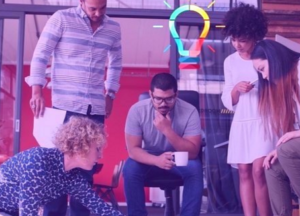Collaboration drives creativity because ideas always emerge from a series of sparks – never a single flash of insight. Improve team innovative thinking.
Are you a creative person? Problem-solver? Learner? All of the above? We consider ourselves in the group of all of the above. Our continuous goal? Obtaining the best creativity.
Creative thinking is the ability to consider something in a new way. It might be a new approach to a problem, a resolution to a conflict between employees, or a new result from a data set. Employers in all industries want employees who can think creatively and bring new perspectives to the workplace
And at the top of our focus areas? Studying and understanding the problem at hand.
Check out our thoughts on team leverage.
Albert Einstein once said that if he had an hour to solve a problem, he’d spend 55 minutes thinking about the problem and 5 minutes thinking about solutions. That is our way of thinking. But not most people.
Creativity doesn’t often happen in a vacuum. As the author Steve Johnson says, chance favors the connected mind. When people are together, talking, laughing, thinking, exploring — they’re going to throw out ideas.
These ideas trigger something in someone else’s mind, and it snowballs. Before long, this group of folks has developed a creative solution that wouldn’t have been possible without the collective collaboration.
Don’t fall prey to the myth that only some people are creative and you’re people are not of the chosen few. We are all creative; it’s just a matter of figuring out in what way.
So find things you’re curious about and are interesting to you, use your imagination a little, stay motivated and work at it, and surround yourself with others who are doing the same. Good ideas, right?
So how do you and your team boost creativity? Here are ten suggestions to improve your ability to exercise ideation within your team:
Innovative thinking … encourage risk taking
Zappos as a company is known as much for its culture as for its creative business model. The company has built a business that is growing rapidly by allowing individuals the freedom to take creative risks without that overwhelming sense of fear or judgment. They tell their employees to say what you think, even if it is controversial.
Make tough decisions without agonizing excessively. Take smart risks. Question actions inconsistent with our values.
Another interesting example: A software company in Boston gives each team member two “corporate get-out-of-jail-free” cards each year. The cards allow the holder to take risks and suffer no repercussions for mistakes associated with them.
At annual reviews, leaders question their team members if the cards are not used.
It is a great way to encourage risk-taking and experimentation. Think this company comes up with amazing ideas? Absolutely.

Be a detective
Creatives and innovators always have enquiring minds. Are you and the team asking enough questions to get deeper and understand the problem as much as you can?
It is not rocket science, is it?
Make quiet time
Most ordinary days of the average worker includes an enormous amount of multitasking. Multitasking is, of course, is very destructive to the time and space of good creative thinking.
Set time aside for team members’ quiet time to stimulate and let the mind wonder until ideas flow. You will be surprised at the results.
Challenge good
The phrases good enough, this has always worked, and this is all the time we have to devote to this problem, etc. are very destructive to team creativity. Avoid these at all costs as they are enemy #1 to the best results.
No question about that.
Foster Autonomy
We all prefer control over our environments. According to a 2008 study by Harvard University, there is a direct correlation between people who have the ability to call their shots and the value of their creative output.
An employee who has to run every tiny detail by her boss for approval will quickly become numb to the creative process.
Have you seen this happen? It will for sure.
The act of creativity is one of self-expression. Granting autonomy involves extending trust. By definition, your team may make decisions you would have made differently.
The key is to provide a clear message of what results you are looking for or what problem you want the team to solve. From there, you need to extend trust and let them do their best work.
They will work well under this model.
Divergent thinking
Try the quantity approach to new ideas. Use brainstorming to improve divergent thinking.
Study and then connect ideas to get new ideas.
Innovative thinking … add play to the equation
When looking for fresh new thinking to solve a problem, shake things up by adding some fun and play with the process. It always can shed the stress and pressure on a team
Explore new experiences
Open up your new idea of thinking. Do things in new and untried ways. Avoid the set ways of solving problems.

Experiment
Do as much experimentation as you can. Don’t worry about failures and allow the team to question any and all assumptions and consider even the craziest ideas.
Always ask why
Here is a favorite story that explains this technique quite well. The story is about why you should ask why. It comes from Ideas Champions.
A consulting company like us (but bigger and more well-known), who specialize in creativity, innovation, team building, and leadership. All favorite topics of ours.
So we certainly keep up with this team.
The story is a big problem at one of our favorite monuments … the Jefferson Memorial in Washington DC.
Simply put, birds in huge numbers were pooping all over it, which made visiting the place a very unpleasant experience.
Attempts to remedy the situation caused even bigger problems since the harsh cleaning detergents being used were damaging the memorial.
Fortunately, some of the National Parks managers assigned to the case began asking WHY as in Why was the Jefferson Memorial so much more of a target for birds than any of the other memorials?
A little bit of investigation revealed the following:
The birds were attracted to the Jefferson Memorial because of the abundance of spiders, a gourmet treat for birds.
The spiders were attracted to the Memorial because of the abundance of midges (insects) that were nesting there.
And the midges were attracted to the Memorial because of the light.
Midges, it turns out, like to procreate in places where the light is just so and because the lights were turned on, at the Jefferson Memorial, one hour before dark, it created the kind of mood lighting that midges went crazy for.
So there you have it: The midges were attracted to the light. The spiders were attracted to the midges. The birds were attracted to the spiders.
And the National Parks workers, though not necessarily attracted to the bird poop, were attracted to getting paid, so they spent a lot of their time (and taxpayer money) cleaning the Memorial.
How did the situation resolve? Very simply. That nail the understanding of the problem, so a creative but simple solution was much easier.
After reviewing the curious chain of events that led up to the problem, the decision was made to wait until dark before turning the lights on at the Jefferson Memorial.
About as simple a solution as you could get. Right?
That one-hour delay was enough to ruin the mood lighting for the midges, who then decided to have midge sex somewhere else.
No midges, no spiders. No spiders, no birds. No birds, no poop. No poop, no need to clean the Jefferson Memorial so often. Case closed.
Now, consider what solutions might have been forthcoming if those curious National Parks managers did not stop and ask WHY:
Hire more workers to clean the Memorial
Ask existing workers to work overtime
Experiment with different kinds of cleaning materials
Put bird poison all around the memorial
Hire hunters to shoot the birds
Encase the entire Jefferson Memorial in Plexiglas
Move the Memorial to another part of Washington
Close the site to the general public
Technically speaking, each of the above solutions was a possible approach, but at great cost, inconvenience, and with questionable results.
Certainly not great solutions, are they?
Key takeaways
Now, think about YOUR business, YOUR life.
What problems are you facing that could be approached differently simply by asking WHY, and then WHY again, and then WHY again … until you get to the real definition of the problem?
If you don’t, you may just end up not correctly defining the problem. Not good. Nothing worse than solving the wrong problem. So put in enough time in understanding and defining your problem.
Don’t leap to problem-solving before you do. Lots of whys help us explore and thoroughly define the problem.
Remember to practice these problem-solving skills as well as asking lots of why questions to form new ideas.

